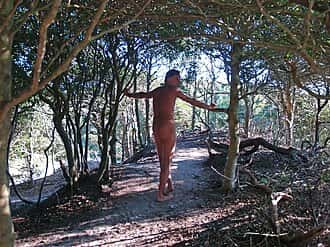Cruising (for sex)
Cruising for sex, or cruising, is walking or driving about a locality in search of a sex partner, usually of the anonymous, casual, one-time variety.[1][2] The term is also used when technology is used to find casual sex, such as using an Internet site or a telephone service.
Contents
Origin and historical usage
According to historian and author Tim Blanning, the term cruising originates from the Dutch equivalent kruisen.
In a specifically sexual context, the term "cruising" originally emerged as an argot "code word" in gay slang, by which those "in the know" would understand the speaker's unstated sexual intent, whereas most heterosexuals, on hearing the same word in the same context, would normally misread the speaker's intended meaning in the word's more common (and presumably less threatening) nonsexual sense. This served (and in some contexts, still serves) as a protective sociolinguistic mechanism for gay men to recognize each other, and avoid being recognized by those who may wish to do them harm in broader societies noted for their homophobia.
In the latter half of the twentieth century, decriminalization of homosexual behaviour increasingly became the norm in English-speaking countries. The protective barrier once provided by the term "cruising" as a "code word" has therefore largely broken down and, arguably, become increasingly irrelevant. Thus the specifically sexual meaning of the term has passed into common usage to include the sexual behavior of heterosexual persons, as well.
Public health officials have noted that cruising locations are frequented by men who have sex with men, but do not identify with being homosexual or bisexual, who are closeted, married, or in relationships with women, do not date men or frequent gay bars, clubs or websites, or have otherwise no other way of meeting men for sex.
Regional usage variants
In the United States, the term "cruising" was used predominantly to denote exclusively homosexual behavior, but in Australia and the United Kingdom it is used by both homosexuals and heterosexuals to describe their own behavior, as witnessed in the common male heterosexual derivative phrase "cruising for chicks".
In the United States, cruising often takes place in gay bars, adult video arcades often through gloryholes, adult movie theaters, public toilets, parks, saunas, gyms or gay bathhouses. Engaging in such activities in public places like parks has led to participants being charged with indecent exposure.
Historic examples of usage
The term has been enshrined since at least the mid-1970s in the name of the gay bar Foxes Booze 'n' Cruise, located on Historic US Highway 66 in Albuquerque, New Mexico. Before closing, the business came under criticism for allegedly encouraging drunk driving by some who did not understand the term's historic usage, but the name and the sign remain a conscious reminder of gay history.
The term has also been adopted, in an altered form, by the website qruiser.com, an online LGBT community based in Sweden. This is a tongue in cheek reference, however, as the community functions as a forum for social interaction for the Scandinavian region, rather than focusing on exclusively sexual encounters. The website has attracted many heterosexual members as well.
In popular culture
Cruising for sex is alluded to in songs such as "Cruisin' the Streets" by the Boys Town Gang as well as "I'm a Cruiser" by the Village People, on the album titled Cruisin'. In 1980, director William Friedkin made the movie Cruising, starring Al Pacino. The film introduced many audiences to homosexual activities and the linguistic codes used for them, but gay rights groups perceived a negative depiction of the gay community in the film and protested its production.
The opening scene of the first episode of the HBO series Looking involves the main character Patrick (Jonathan Groff) cruising in a park, mainly out of curiosity of whether the activity is still in practice or not.
Cruising for sex was explored in Cruising Pavilion, a 2018 art installation associated with the Venice Bienalle of Architecture.
See Also
- North America | South America | Europe | Africa | Asia | Oceania

